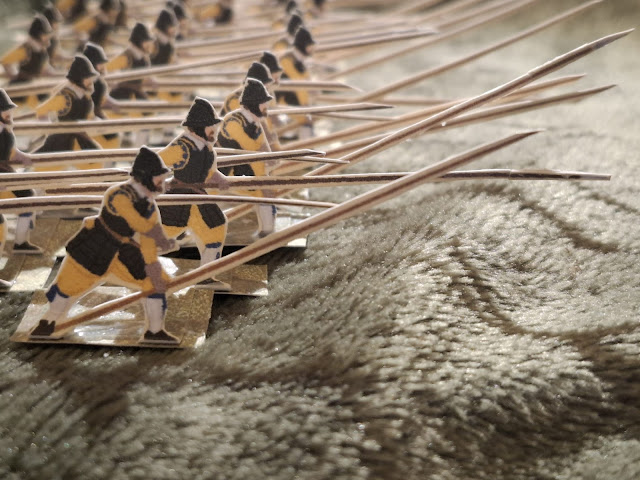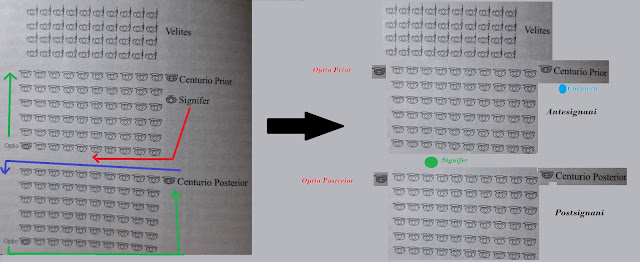With the term "cornicem" is it intended the men that used the "cornus", i.e. horn to give orders to the troops, under the command of a Centurio.
PAPERSOLDIERS JOURNAL
Friday, July 11, 2025
ROMAN LEGION - REPUBLIC PERIOD (298 - 105 BC). LESSON Nr. 2: THE CORNICEN
Monday, July 7, 2025
1632 BATTLE OF LUTZEN YELLOW BRIGADE - PICTURES
Time ago I was wondering about the Yellow Brigade at the Battle of Lutzen in 1632.
I prepared some templates,
https://www.blogger.com/blog/post/edit/3755658264788069799/2327466852317935793
I printed them, trimmed, glued, put the magnet underneath.
Finally today I decided to post some pictures of them, just to give idea how from a pictures you can obtain a papersoldier.
Monday, June 30, 2025
ROMAN LEGION - REPUBLIC PERIOD (298 - 105 BC). LESSON Nr. 1: THE SIGNIFER
I always wanted to postpone this topic, in order to have 1 legion at 1:1 ratio to show. But I think this is a long time ahead and I cannot resist to share with you what I have learned from my researches. Above all, because Italian books on this topic are far better and better detailed - as you will see in the next lessons - than the English written books.
I am indeed preparing a "Polybian" Legion (Polybius was the Greek writer, contemporary to the Republican Legion that better described how a Legion worked) at 1:1 ratio, but my numbers are still very small (I am preparing at the same time the 3rd Battle of Ramla and the Battle of Turin 1706); so I need a lot of time to complete my purpose.
The first point to be pointed out immediatly is that no one ever described precisely how a Republican Legion actually worked. There are theories (mostly wrong) about the triple acies, but it is not clear how it actually worked, as said.
The Italian books that I will quote are the unique indeed that with a comparision of different passages (quoted in Latin or Ancient Greek) are able to give an idea of the way it worked. This will solve one an for ever the numbers of a Legion and a lot of other problems. The rest will be up to me and to my 1:1 ratio papersoldier Legion.
Let's start from the number and position of the "Signum" (insign), plural "Signa" inside the maniple. And let's start from the Osprey "Roman Republican Legionary - 298 - 105 BC"
So the text contradicts itself in few rows: at the top it say that every century had a standard. Though a maniple was formed by 2 centuries it means that every maniple (2 centuries) had 2 signa; but later, just few rows down it states (correctly) that there was only 1 signum per maniple, so 1 every 2 centuries. This points out very clearly the mistake the Author incurred in this case.
This one, written by Dario Battaglia and Luca Ventura through the analysis of ancient text and critics to old theories opens a new light on the real working of a Legion in the Republican period.
Thursday, June 12, 2025
1706 BATTLE OF TURIN - STANDARD NORMANDIE REGIMENT 2020 vs 2025
In some previous posts I was commenting about the fact that I was preparing new poses for the Normandie Regiment that I would have not used. It was not true. In fact, I started to prepare new poses and here I would like to show the differences between a standard-bearer done in 2020 and that done now 2025
Tuesday, May 6, 2025
ROMAN LEGIONAR: PUNIC WARS vs MARIUS & CAESAR'S WARS
It is interesting to investigate how the uniforms - i.e. the appearance of the Roman legionar changed fron the period of the Punic Wars (III Century b.C.) to the Caesar's period (I Century b.C.). It is also to be pointed out that uniforms were not so "uniform" and variations happened all the time in a slow evolution.
To recreate the evolution of the Roman Army I started from the series "My First Wargame" a real must for papersodiers. I did not know they also published the Roman Army during Punic wars.
In any case, from an image of this, I increased (at east this is my opinion) the features of the template
From the Caesar's template I did the Punic Wars' template
Thursday, April 17, 2025
1105 - THIRD BATTLE OF RAMLA - FATIMYD LIGHT CAVALRY 2nd PART
As promised, here I ma with some picture of the 120 horses of Fatimyd light cavalry. I tried to pose them is a sort of attack to a Crusade town, just out of pleasure to set up a scenario. The ratio is 1:1.
The effect of the charges is well represented with banners and flags in the front.
Some pictures with a total view on the facing: light Fatimid cavalry on the right and Crusaders on the left
Monday, April 14, 2025
PAPERSOLDIERS ON SELL
After a while and some doubts, considering that some of you requested templates or papersoldiers to be sold, I am (re)considering to sell them.
The options are:
a) just the template
b) papersoldiers already trimmed:
The first option would have a very limited costs (Euro 5 per template), while the others more expensive, considering the huge work necessary to be done:
- papersoldiers trimmed: nr. 10 papersoldiers Euro 3,75
- papersoldiers trimmed and glued to basis + reinfocement: nr. 10 papersoldiers Euro 4,30
For any request, write me on this blog. Thanks

















.png)
%20parrucca.png)















